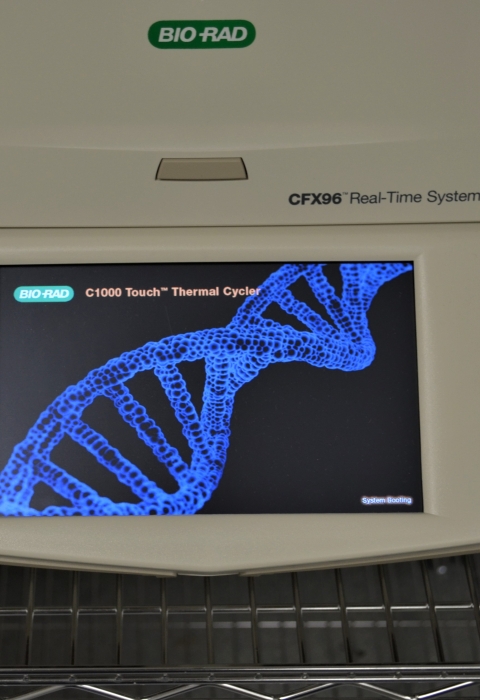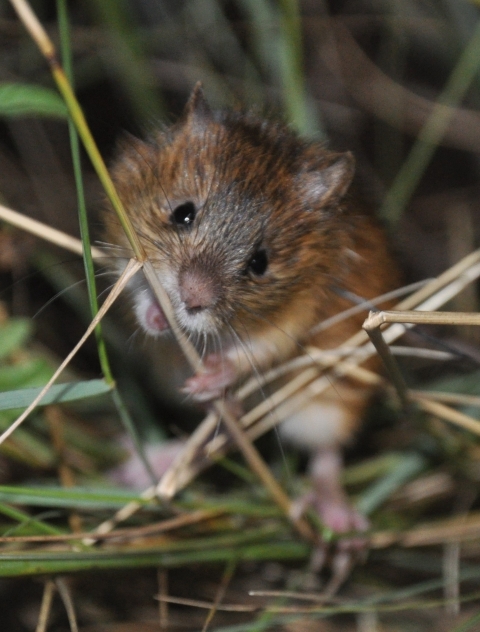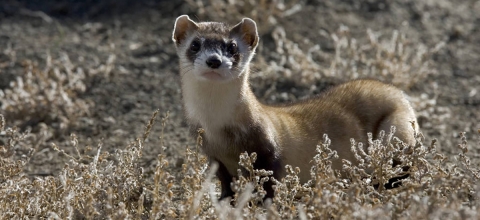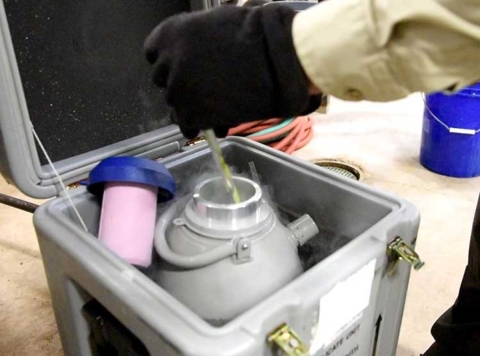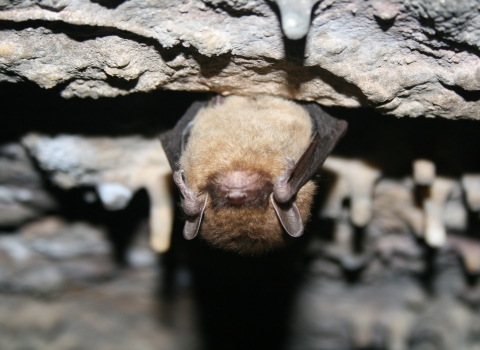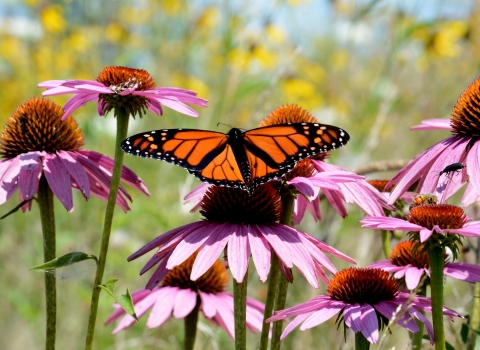Deep in the wilds of the American Southwest, the secretive and endangered New Mexico meadow jumping mouse continues, against all odds, to eke out a living adjacent to the rare and dwindling rivers and streams of this high-altitude, arid region. One dark night, a tiny mouse smells something delicious; the odor emanates from inside an open metal box. Very cautiously and with much hesitation, the mouse proceeds inside to retrieve the meal. Suddenly, a metal plate beneath its feet falls, triggering a spring-loaded mechanism, and the sixth side of the box falls into place. The mouse is trapped inside with its costly prize.
Lucky for this tiny mammal, the following morning a biologist with the U.S. Fish and Wildlife Service conducting a survey opens the cage. They check the mouse’s overall health, take measurement, and collect a tissue sample: a miniscule biopsy punch from the mouse’s ear. They observe the tiny creature for some time to make sure it’s stable after the trapping and sampling, and then release it back to its wild meadow mouse life.Watch Scripps News story on this field work.
While taking blood and tissue samples for lab analysis is routine work during imperiled species surveys, this tissue could be a premium on a state-of-the-art species’ life insurance policy. It will be shipped off to a genetics lab and a -256-degree Fahrenheit freeze for its long-term preservation, or biobanking. How these tissues may eventually be used is unknown.
“We’re trying to bring 21st century solutions to 21st century conservation challenges,” said Seth Willey, a wildlife biologist and Deputy Assistant Regional Director of Ecological Services for the Service’s Southwest Region. He and his team have been spearheading a biobanking program for the Service and Region. “Here in the Southwest, our wildlife diversity took literally millions of years to develop, and despite our best efforts, we’re continuing to lose some of that genetic diversity every year. With biobanking, we’re trying to use modern tools to preserve America’s genetic diversity — our natural heritage — for future generations.”
Preserving endangered species tissue isn’t new. For plants, seed banks make them easier to bring back after a long period of absence. The preservation of fish genetics for long periods has been around for a lifetime, as their reproductive cells are amenable to freezing. But for our fellow mammals, a more nuanced approach is also being employed. Recent, cutting-edge techniques by genetics researchers such as biodiversity non-profit Revive and Restore usher science fiction into scientific reality and may be a key factor in assuring resilience and recovery for one endangered mammal.
“Decades ago, someone had the forethought to preserve the genetics of endangered black-footed ferrets. Today that ferret’s entire recovery population comes from seven founders,” said Brian Small, a wildlife biologist who’s the Biobanking Project Lead for the Service’s Southwest Region. “Although 18 ferrets were brought into captivity from the last wild population, only seven are genetic founders of today’s population.
“Amazingly, in 1988, two individuals that were not able to pass their genes to today’s ferrets were cryogenically preserved in the San Diego Frozen Zoo as frozen cell cultures. Then decades later in 2020, a partnership including the Service, Revive and Restore, ViaGen Pets & Equine, and the San Diego Zoo Wildlife Alliance successfully cloned an eighth potential founder they named Elizabeth Ann. If we can add those new genetics to the recovery population, it could have a strong response to increasing the species diversity and resiliency.”
In that circumstance, recovering single individual represents a 14 percent potential increase to the remaining gene diversity of North America’s only native ferret. Things aren’t quite yet so dire for Southwest Region’s six pilot biobanking species, which, in addition to the New Mexico meadow jumping mouse, include the Peñasco least chipmunk also in New Mexico, the Texas kangaroo rat, Mexican wolf, and Arizona’s Sonoran pronghorn and Mt. Graham red squirrel. However, for most of them, their situation is unfortunately trending downward, which is why it’s so important to bank their genetics now.
“Biobanking is an insurance policy essentially. It's not going to help us recover the jumping mouse tomorrow, but it's something we can start to work on now,” said Service Fish and Wildlife Biologist Mark Brennan, who is the species lead for the New Mexico meadow jumping mouse. He collects those ear punches and sends them to deep freeze facilities. “Saving the genetic material we have now could help recovery in the future. For example, if we lose a population or one goes through a bottleneck, saving cell cultures now could possibly allow us to bring back that population’s unique traits.”
"This program provides genomic insight for today's conservation decisions, in addition to building an insurance policy for the future," said Revive and Restore Executive Director Ryan Phelan. "Each biobanked sample will be sequenced and made available to the scientific community to inform decisions related to captive breeding, climate resilience, and disease risk. Biobanking is just as much about the present as it is about the future."
And while the possibilities are endless in what the future holds, biologists offer a word of caution to those who would like to declare victory when biobanking a species.
“What we don’t want is for people to get complacent and think that we can just put the tissue sample in the freezer and no longer worry about protecting its habitat or continuing current recovery efforts,” cautioned Brennan. “Biobanking isn’t a panacea. It doesn’t fix everything. It’s just another tool in the recovery toolbox.”
December 2023 marks the 50th anniversary of the Endangered Species Act of 1973. Each imperiled species is a part of the web of life, and have a unique cultural and biological community, performing services that are essential to our combined well-being. By conserving them, we help ensure the benefits that accrue from them—healthy air, land, and water—on which we depend. Endangered species recovery is complex and difficult work, often requiring substantial time and resources. Species today face ongoing threats like habitat loss as well as new threats like climate change climate change
Climate change includes both global warming driven by human-induced emissions of greenhouse gases and the resulting large-scale shifts in weather patterns. Though there have been previous periods of climatic change, since the mid-20th century humans have had an unprecedented impact on Earth's climate system and caused change on a global scale.
Learn more about climate change and wildlife trafficking. We have a continued commitment as a nation to protect imperiled species.
Today, hundreds of species are stable or improving, or least have hope, thanks to management actions or our partners. For biobanking, U.S. Department of Agriculture and San Diego Frozen Zoo are vital in the cryopreservation of genetic samples. Revive and Restore, Viagen Pets & Equine, and other partners share a commitment to build on our accomplishments and expand innovative initiatives to further this mission in the future.
